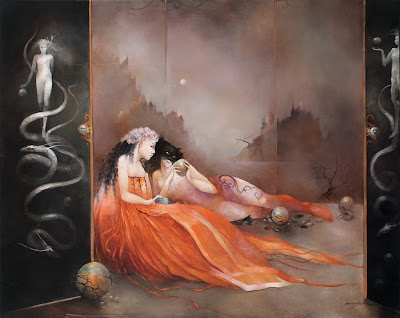
“Kitsune Noir” by Laura Laine
The Kitsune (Japanese for fox) has a long and fascinating history in Japanese culture. They are particularly well-known for shape-shifting into the form of exquisitely beautiful women, especially with “a narrow face with close-set eyes, thin eyebrows, and high cheekbones” (Wikipedia). They make very convincing ladies, and in many tales will marry and have children before being surprised into showing their true identity. Some ways to discern Kitsune from women are to get them drunk (and careless), to look at their shadow or reflection (which may show their true form), or to look for a tail, which is often difficult for them to hide. And a Kitsune, depending on the strength of its powers, can have up to nine tails...


The presence of dogs also often gives away a shape-hiding Kitsune, as the barking really rattles them.
According to Karen Ann Smyers, in The Fox and the Jewel,
“The earliest extant fox story in Japan also purports to explain the etymology of the word for fox, “kitsune.” A sixth-century man from Mino one day met a woman in the fields. She agreed to marry him, and soon they had a son, and at the same time, their dog had puppies. Life was peaceful, except for the incessant barking of their puppy at the wife. She begged her husband to kill it, but he felt compassion for it and could not bring himself to do so. One day the dog startled the wife with its barking, and suddenly she reverted to her true fox shape, perched upon a rough fence. Although the husband was surprised, his love for his wife was deep, and he told her that he would never forget her, and that she should come back to sleep with him, which she did, nightly. Her name, and the name of all subsequent foxes in Japan, was therefore Kitsune, ‘come and sleep.’
“The fox in this story is a good wife and mother, but another kind of fox-woman in Japanese stories seduces men and makes fools of them. Foxes in human form may play harmless pranks, or they may possess people against their will. Spirit foxes were employed to nefarious ends by sorcerers; mediums and healers may be assisted in their tasks by white spirit foxes even today. Fox stories in the rakugo and Kyogen traditions are hilarious; the more macabre tales can be nauseatingly gruesome. Foxes are associated with the earth where they make their homes, with fire, with sexuality; they can fly, change shape, cause mirages. They range from villainous to saintly.”
In fact, their behavior can be so villainous, there is a Kitsune-okuri (fox-expelling) festival in the Totomi province of Japan every year on January 14th. A procession of people carrying straw foxes is led out of town by a priest, where they bury the dolls, thus buying themselves protection for the following year.
Otherwise, the Kitsune would be free to possess hapless victims, start fires or throw lightning with their tails, waylay travelers with something much like a siren’s song, and overwhelm ordinary locals with elaborate illusions. “Some tales speak of kitsune with even greater powers, able to bend time and space, drive people mad, or take fantastic shapes such as a tree of incredible height or a second moon in the sky. Other kitsune have characteristics reminiscent of vampires or succubi and feed on the life or spirit of human beings, generally through sexual contact.....”(Wikipedia)
In a demonic fox possession (until the early 20th century, a common diagnosis for the mentally ill), the fox enters a young woman (always a young woman) by sliding underneath her fingernails or into her breasts. You might realize what’s happening by a subtle shift in her facial features, making them slightly more...“fox-like.” The possessed young lady may have abilities she didn’t have before--a newly-gained literacy, for example, or knowledge of a foreign language. And she will have sudden, relentlessly ravenous cravings for fox-favored foods, like tofu, sweet red beans, and rice. If she recovers, having had a successful exorcism, it is likely she will never be able to eat those foods again.
The actual grisly possession is described in Lafcadio Hearn’s Glimpses of Unfamiliar Japan:
“Strange is the madness of those into whom demon foxes enter. Sometimes they run naked shouting through the streets. Sometimes they lie down and froth at the mouth, and yelp as a fox yelps. And on some part of the body of the possessed a moving lump appears under the skin, which seems to have a life of its own. Prick it with a needle, and it glides instantly to another place. By no grasp can it be so tightly compressed by a strong hand that it will not slip from under the fingers.”
In A Field Guide to Demons, Fairies, Fallen Angels, and Other Subversive Spirits, Dinah Mack traces this less friendly, demonic aspect of the Kitsune to old tales of the Fox Fairy in China:
“There, the Fox Fairy is greatly feared and always propitiated. It is believed that cases of madness caused by fox possession are retributions for former offenses against the Fox Fairy by a member of the victim’s family; however, the Chinese Fox Fairy has been known to possess a human being for the sheer malevolent mischief of it. When inhabited, the human can fly, go through walls, and has other striking powers...
A priest is often called in, berates the Fox Spirit, and tells it to get out. The fox negotiates its terms, arranges for rice and other offerings, and if satisfied will finally agree to leave. Cases continue to be reported in contemporary times.”

“Haunted House” (I recommend clicking the link for a better view of the creepiness of these two images...)


However, according to The Complete Idiot’s Guide to World Mythology,
“Tengu and Kitsune, though they are certainly not human, should not be thought of as monsters. In fact, they are more like demon-angel hybrids, in that they have capacities for good and evil that are similar to those of humans.”
In fact, throughout history, the white Kitsune have been strongly associated with the spirits of the rice fields, and gods of nourishment. And let’s not forget that some of those lovely ladies make angelic wives and loving mothers...

“Hide and Chic”
While studying the extensive lore surrounding this creature (so much more than fits in this post!), I discovered
How to achieve magical powers!
In The Catalpa Bow, a Study in Shamanistic Practices in Japan, by Carmen Blacker, she describes 17th century accounts of an Izuna rite:
“For this rite you must first find a pregnant vixen in her lair. You feed her and tame her, taking particular care of her at the time when her cubs are born. When the cubs are grown up, the vixen will bring one of them to you and ask you to give it a name. Once you have done this you will find that you only have to call the young fox by name for it to come to you in invisible form. Then you can ask it any questions you like, on any matter however secret, and always it will be able to find out the answer for you. Other people cannot see the fox in its invisible form, so when you show them that you know of these hidden things they will all think that you possess divine power.
This peculiar rite, described in almost identical terms in several Tokugawa works, seems to be a degraded vestige of something which in early medieval times was a religious rite of heretical but not very evil character. The Izuna rite...was at this period another name for the Dagini or Daten rite, much performed by warriors, noblemen or priests anxious for power or wealth. It was by dint of performing the Dagini rite...that Taira Kiyomori rose from obscurity to be virtual dictator of the land...References throughout medieval literature are legion to the successful performance of this rite by perfectly respectable people.”
All the artwork in this post is by the Finnish artist Laura Laine, whose work I discovered via Phantasmaphile. Her own webpage is here. She is rather famous for her fashion illustrations, featuring foxy models with fantastically-detailed hair:

(Anyone else see possible tails, here?)
Also, this fantastic collection of the horoscope figures:

“Horoscopes”
She also applied her fantastic attention to detail in the creation of this modern version of the traditional Japanese Kokeshi doll (now owned by another lovely artist, Audrey Kawasaki) for the Kokeshi show earlier this fall at the Japanese American National Museum:

Kokeshi

(Close-up)
Note the three hands--one fiddling with her hair--and the rather possessed look in the eyes....
I am traveling this month and am unlikely to get a chance to post again until the new year. I hope everyone has a great holiday and luxuriates in tons of life-affirming celebrations, full of spirit, health and joy!





.jpg)











.jpg)























